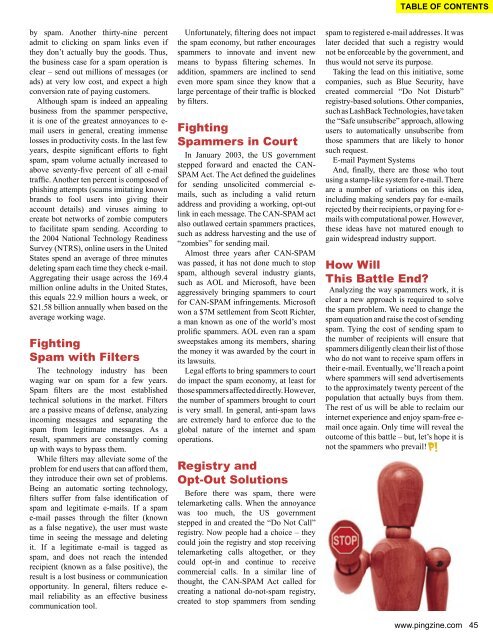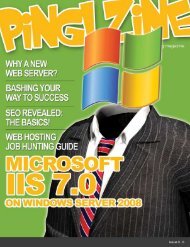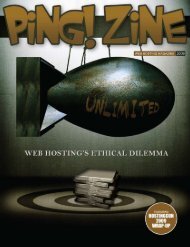bits & bytes - Ping! Zine Web Tech Magazine
bits & bytes - Ping! Zine Web Tech Magazine
bits & bytes - Ping! Zine Web Tech Magazine
You also want an ePaper? Increase the reach of your titles
YUMPU automatically turns print PDFs into web optimized ePapers that Google loves.
y spam. Another thirty-nine percent<br />
admit to clicking on spam links even if<br />
they don’t actually buy the goods. Thus,<br />
the business case for a spam operation is<br />
clear – send out millions of messages (or<br />
ads) at very low cost, and expect a high<br />
conversion rate of paying customers.<br />
Although spam is indeed an appealing<br />
business from the spammer perspective,<br />
it is one of the greatest annoyances to e-<br />
mail users in general, creating immense<br />
losses in productivity costs. In the last few<br />
years, despite significant efforts to fight<br />
spam, spam volume actually increased to<br />
above seventy-five percent of all e-mail<br />
traffic. Another ten percent is composed of<br />
phishing attempts (scams imitating known<br />
brands to fool users into giving their<br />
account details) and viruses aiming to<br />
create bot networks of zombie computers<br />
to facilitate spam sending. According to<br />
the 2004 National <strong>Tech</strong>nology Readiness<br />
Survey (NTRS), online users in the United<br />
States spend an average of three minutes<br />
deleting spam each time they check e-mail.<br />
Aggregating their usage across the 169.4<br />
million online adults in the United States,<br />
this equals 22.9 million hours a week, or<br />
$21.58 billion annually when based on the<br />
average working wage.<br />
Fighting<br />
Spam with Filters<br />
The technology industry has been<br />
waging war on spam for a few years.<br />
Spam filters are the most established<br />
technical solutions in the market. Filters<br />
are a passive means of defense, analyzing<br />
incoming messages and separating the<br />
spam from legitimate messages. As a<br />
result, spammers are constantly coming<br />
up with ways to bypass them.<br />
While filters may alleviate some of the<br />
problem for end users that can afford them,<br />
they introduce their own set of problems.<br />
Being an automatic sorting technology,<br />
filters suffer from false identification of<br />
spam and legitimate e-mails. If a spam<br />
e-mail passes through the filter (known<br />
as a false negative), the user must waste<br />
time in seeing the message and deleting<br />
it. If a legitimate e-mail is tagged as<br />
spam, and does not reach the intended<br />
recipient (known as a false positive), the<br />
result is a lost business or communication<br />
opportunity. In general, filters reduce e-<br />
mail reliability as an effective business<br />
communication tool.<br />
Unfortunately, filtering does not impact<br />
the spam economy, but rather encourages<br />
spammers to innovate and invent new<br />
means to bypass filtering schemes. In<br />
addition, spammers are inclined to send<br />
even more spam since they know that a<br />
large percentage of their traffic is blocked<br />
by filters.<br />
Fighting<br />
Spammers in Court<br />
In January 2003, the US government<br />
stepped forward and enacted the CAN-<br />
SPAM Act. The Act defined the guidelines<br />
for sending unsolicited commercial e-<br />
mails, such as including a valid return<br />
address and providing a working, opt-out<br />
link in each message. The CAN-SPAM act<br />
also outlawed certain spammers practices,<br />
such as address harvesting and the use of<br />
“zombies” for sending mail.<br />
Almost three years after CAN-SPAM<br />
was passed, it has not done much to stop<br />
spam, although several industry giants,<br />
such as AOL and Microsoft, have been<br />
aggressively bringing spammers to court<br />
for CAN-SPAM infringements. Microsoft<br />
won a $7M settlement from Scott Richter,<br />
a man known as one of the world’s most<br />
prolific spammers. AOL even ran a spam<br />
sweepstakes among its members, sharing<br />
the money it was awarded by the court in<br />
its lawsuits.<br />
Legal efforts to bring spammers to court<br />
do impact the spam economy, at least for<br />
those spammers affected directly. However,<br />
the number of spammers brought to court<br />
is very small. In general, anti-spam laws<br />
are extremely hard to enforce due to the<br />
global nature of the internet and spam<br />
operations.<br />
Registry and<br />
Opt-Out Solutions<br />
Before there was spam, there were<br />
telemarketing calls. When the annoyance<br />
was too much, the US government<br />
stepped in and created the “Do Not Call”<br />
registry. Now people had a choice – they<br />
could join the registry and stop receiving<br />
telemarketing calls altogether, or they<br />
could opt-in and continue to receive<br />
commercial calls. In a similar line of<br />
thought, the CAN-SPAM Act called for<br />
creating a national do-not-spam registry,<br />
created to stop spammers from sending<br />
spam to registered e-mail addresses. It was<br />
later decided that such a registry would<br />
not be enforceable by the government, and<br />
thus would not serve its purpose.<br />
Taking the lead on this initiative, some<br />
companies, such as Blue Security, have<br />
created commercial “Do Not Disturb”<br />
registry-based solutions. Other companies,<br />
such as LashBack <strong>Tech</strong>nologies, have taken<br />
the “Safe unsubscribe” approach, allowing<br />
users to automatically unsubscribe from<br />
those spammers that are likely to honor<br />
such request.<br />
E-mail Payment Systems<br />
And, finally, there are those who tout<br />
using a stamp-like system for e-mail. There<br />
are a number of variations on this idea,<br />
including making senders pay for e-mails<br />
rejected by their recipients, or paying for e-<br />
mails with computational power. However,<br />
these ideas have not matured enough to<br />
gain widespread industry support.<br />
How Will<br />
This Battle End?<br />
Analyzing the way spammers work, it is<br />
clear a new approach is required to solve<br />
the spam problem. We need to change the<br />
spam equation and raise the cost of sending<br />
spam. Tying the cost of sending spam to<br />
the number of recipients will ensure that<br />
spammers diligently clean their list of those<br />
who do not want to receive spam offers in<br />
their e-mail. Eventually, we’ll reach a point<br />
where spammers will send advertisements<br />
to the approximately twenty percent of the<br />
population that actually buys from them.<br />
The rest of us will be able to reclaim our<br />
internet experience and enjoy spam-free e-<br />
mail once again. Only time will reveal the<br />
outcome of this battle – but, let’s hope it is<br />
not the spammers who prevail!P!<br />
www.pingzine.com 45
















